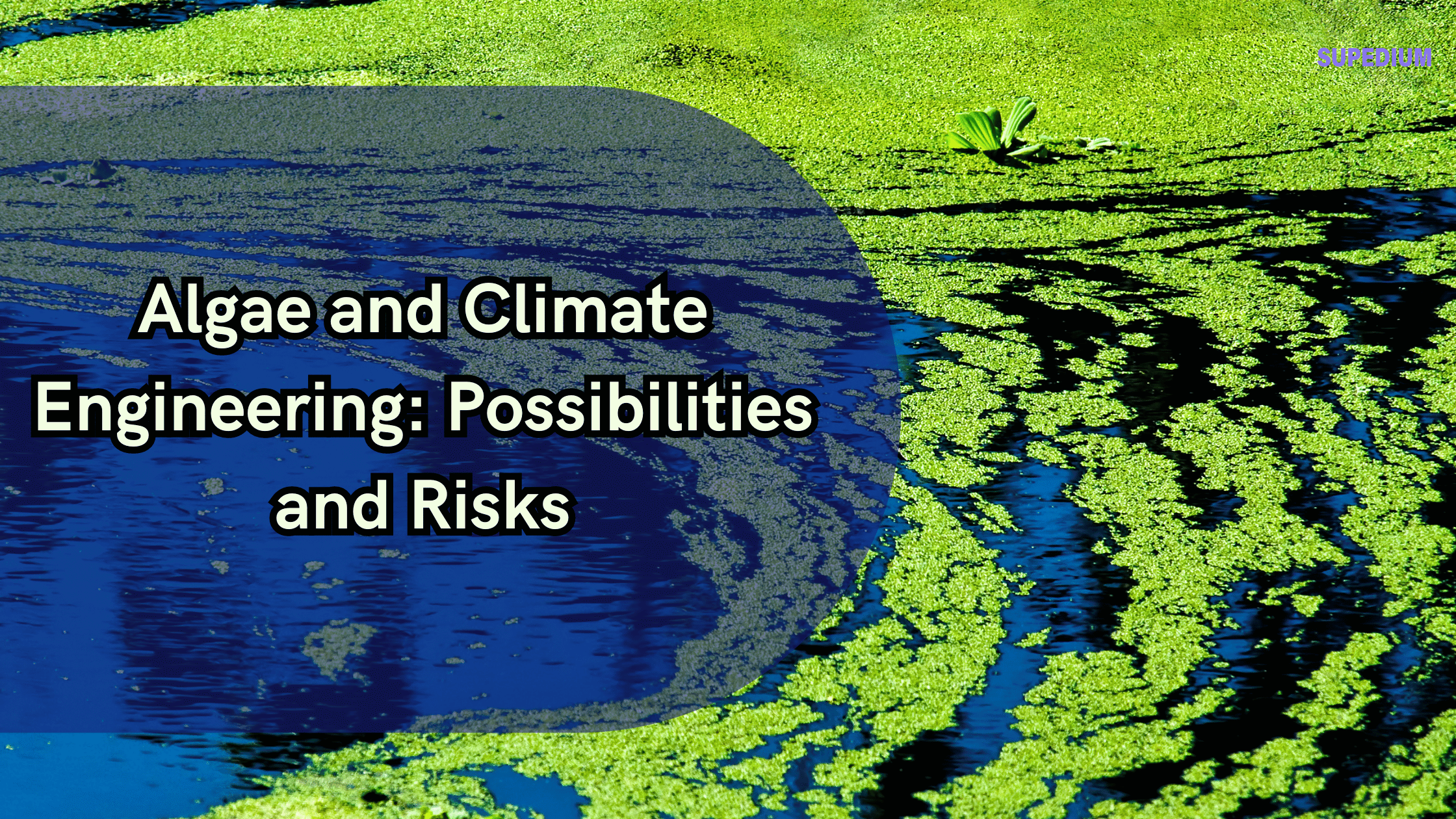Table of Contents
![]()
Climate engineering, or geoengineering, refers to deliberate efforts to modify the Earth’s climate system to counteract the effects of climate change. Among the diverse methods being explored, algae-based techniques offer intriguing possibilities due to algae’s unique biological properties and rapid growth rates. However, these techniques also come with potential risks that need careful consideration. This article delves into the possibilities and risks of using algae in climate engineering.
Algae-Based Climate Engineering Techniques
1. Carbon Dioxide Removal (CDR)
Algae Cultivation for Carbon Sequestration
Algae, through photosynthesis, absorb carbon dioxide (CO2) from the atmosphere and convert it into biomass. This process makes algae a potential tool for carbon sequestration. Certain types of algae, such as microalgae and macroalgae, have high photosynthetic efficiencies and growth rates, allowing them to capture significant amounts of CO2. Large-scale algae cultivation projects have been implemented in various parts of the world, demonstrating the potential of algae to reduce atmospheric CO2 levels.
For instance, microalgae systems, often housed in photobioreactors, can be optimized to capture CO2 from industrial emissions, providing a dual benefit of reducing greenhouse gas emissions and producing valuable biomass. Macroalgae, or seaweeds, grow in marine environments and can sequester carbon as they grow, with potential applications in both coastal and open-ocean environments.
Ocean Fertilization with Algae
Ocean fertilization involves adding nutrients to the ocean to stimulate the growth of phytoplankton, including algae, which can absorb CO2. This technique aims to enhance the ocean’s natural carbon sink capacity. Techniques used include the direct addition of nutrients like iron or nitrogen to the ocean. While this approach holds promise, it has been met with mixed results. Some experiments have led to significant algal blooms and increased carbon sequestration, while others have raised concerns about ecological disruptions and unintended consequences, such as the creation of dead zones due to nutrient overloading.
2. Bioenergy with Carbon Capture and Storage (BECCS)
Algae as a Source of Biofuels
Algae can be converted into biofuels such as biodiesel, bioethanol, and biogas. Algae’s rapid growth and high oil content make it an attractive feedstock for biofuel production. The energy yield from algae-based biofuels is competitive with other renewable energy sources, and advancements in algal biofuel technologies continue to improve efficiency and reduce costs.
Integration with Carbon Capture
Combining algae biofuel production with carbon capture and storage (CCS) can potentially create a negative emissions system. During biofuel production, CO2 is absorbed by the algae and later released when the biofuel is burned. By capturing and storing this CO2, the process could effectively reduce atmospheric CO2 levels. This integration presents a promising strategy for mitigating climate change but requires further research to optimize the entire system and assess its feasibility on a large scale.
3. Algae in Urban and Agricultural Settings
Algae-Based Biofilters and Green Roofs
In urban environments, algae can be used in biofilters to reduce air pollution and in green roofs to mitigate the urban heat island effect. Algae-based systems can absorb CO2 and pollutants from the air, while also providing cooling effects through evapotranspiration. The potential benefits include improved air quality and reduced energy consumption for cooling buildings. However, the effectiveness of these systems depends on design, maintenance, and local environmental conditions.
Agricultural Applications
Algae can also play a role in agriculture as soil enhancers. Algal biomass can be used to improve soil health, enhance water retention, and increase carbon sequestration in soils. The use of algae in agriculture could lead to more sustainable farming practices and contribute to the overall carbon balance. Research into the specific benefits and limitations of algae-based soil amendments is ongoing.
Potential Benefits of Algae-Based Climate Engineering
1. Environmental Impact
Reduction in Atmospheric CO2
Algae-based climate engineering techniques offer significant potential for reducing atmospheric CO2. Algae’s ability to sequester carbon efficiently makes it a valuable tool in the fight against climate change. Comparative studies show that algae-based methods can provide substantial CO2 reductions, potentially complementing other carbon removal strategies.
Improvement in Air and Water Quality
Beyond CO2 sequestration, algae can improve air and water quality. In addition to absorbing CO2, algae can remove pollutants from air and water, contributing to overall environmental health. Case studies have demonstrated that algae-based systems can enhance water quality by removing excess nutrients and pollutants, benefiting ecosystems and human health.
2. Economic and Social Benefits
Job Creation and Industry Growth
The development of algae-based technologies has the potential to create new industries and job opportunities. From algae cultivation and biofuel production to system design and maintenance, the algae industry can contribute to economic growth and employment. Successful algae-related businesses and projects provide examples of the economic benefits that can arise from this sector.
Sustainable Development
Algae offer a renewable resource with the potential to contribute to sustainable development. As a fast-growing and versatile organism, algae can be integrated into circular economy principles, where waste products are reused and resources are managed sustainably. This approach aligns with broader goals of reducing environmental impact and promoting sustainability.
Risks and Challenges
1. Environmental Risks
Unintended Ecological Consequences
One of the primary concerns with algae-based climate engineering is the potential for unintended ecological consequences. Large-scale algae cultivation and ocean fertilization can disrupt local ecosystems, alter nutrient balances, and lead to algal blooms that create dead zones. These risks necessitate careful planning, monitoring, and management to minimize negative impacts.
Biodiversity Concerns
Algae-based interventions can also affect biodiversity. The introduction of non-native algae species or changes in nutrient dynamics can impact local flora and fauna. Ensuring that algae-based projects do not inadvertently harm biodiversity is crucial for maintaining ecological balance.
2. Technical and Logistical Challenges
Scaling Up
Scaling up algae cultivation and processing from experimental to commercial levels presents several challenges. Issues such as infrastructure requirements, cost, and resource management need to be addressed to make algae-based technologies viable on a large scale. Ongoing research and development are essential to overcome these challenges and optimize systems for broader application.
Resource and Energy Requirements
Algae cultivation requires inputs such as water, nutrients, and energy. Balancing the resource and energy requirements of algae-based systems with their environmental benefits is important for ensuring overall sustainability. Efforts to improve efficiency and reduce inputs will be critical for the success of algae-based climate engineering.
3. Societal and Ethical Issues
Public Acceptance and Policy
Public perception and policy play significant roles in the development and implementation of algae-based climate engineering technologies. Gaining public acceptance and navigating regulatory frameworks are essential for the successful deployment of these technologies. Engaging with stakeholders and addressing concerns transparently can help facilitate positive outcomes.
Equity and Access
Equity and access issues must be considered when implementing algae-based climate engineering solutions. Ensuring that benefits are distributed fairly and that technology is accessible to different regions and communities is important for achieving global climate goals. Addressing these issues requires inclusive planning and international cooperation.
Future Directions and Research
1. Innovations in Algae Technology
Advances in Genetic Engineering
Genetic engineering offers the potential to create algae strains with enhanced properties for climate engineering. This could include improved growth rates, higher carbon sequestration capabilities, or better adaptability to various environments. Ethical considerations and regulatory challenges will need to be addressed as these technologies advance.
Integration with Other Climate Engineering Methods
Combining algae-based techniques with other climate engineering methods, such as solar radiation management, could enhance overall effectiveness. Integrated approaches that leverage multiple strategies may provide more robust solutions for mitigating climate change. Research into synergies between different methods will be crucial for developing comprehensive climate strategies.
2. Long-Term Monitoring and Assessment
Need for Comprehensive Monitoring
Long-term monitoring of algae-based climate engineering projects is essential for understanding their environmental and social impacts. Implementing robust monitoring systems and adaptive management strategies will help ensure that projects achieve their intended goals while minimizing adverse effects.
Research Priorities
Future research should focus on optimizing algae cultivation and processing technologies, assessing long-term impacts, and exploring innovative applications. Collaboration between scientists, industry, and policymakers will be key to advancing algae-based climate engineering and addressing emerging challenges.
Conclusion
Algae-based climate engineering holds significant potential for mitigating climate change through carbon dioxide removal, bioenergy production, and environmental enhancement. However, the benefits come with risks and challenges that must be carefully managed. Balancing innovation with caution, addressing technical and societal issues, and fostering collaboration will be essential for realizing the full potential of algae in climate engineering. As research and development continue, algae may play a crucial role in global efforts to address climate change and promote a sustainable future.
Share This





Be the first to comment